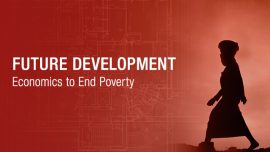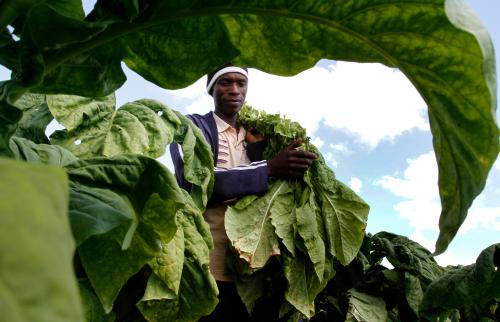There is a big gulf in many Americans’ understanding of global events: wonderful things are happening, just not here.
A generation ago, 50 percent of humanity was malnourished, with calamitous famines widely predicted. The United Nations Food and Agriculture Organization reported in 2015, the most recent year for which statistics are available, that malnutrition has declined to the lowest level in human history. Today only 12 percent of the world’s population goes hungry. Of course 12 percent is too high, but the number means there are more than 6 billion people who eat sufficient meals. That’s four times the total number of people alive when Theodore Roosevelt was the United States president.
Per-capita production of grain, beef, poultry, and dairy is rising faster than population almost everywhere in the world, in no small part owing to efforts supported by the U.S.
American agronomists of the 1940s and 1950s developed hybrid cereals that made the farms of poor nations more productive. Mexico played a little-appreciated role in this effort: Its International Maize and Wheat Improvement Center, known by the Spanish acronym CIMMYT, was groundbreaking in more than the punning sense. Under U.S. President Barack Obama, the Agency for International Development shifted attention toward agricultural research specific to the soil and climate of poor nations. Owing in part to this, some regions in Africa are already on track to become agricultural exporters.
In the summer of 2016, as election-year negativism went off the charts, a genuine bipartisan event occurred on Capitol Hill. There was a bill to fund Green Revolution crop research in Africa—not for Africa but in Africa, at research installations such as the Africa Rice Center in Côte d’Ivoire. Had this proposal triggered fist-shaking legislative gridlock, it would have been all over the news. Instead, the legislation passed the Senate by voice vote and the House by 369-53, with Republicans and Democrats reaching broad agreement—and so the bill was ignored by the White House contenders and by the mainstream media. The result is that most Americans don’t know that world hunger is in dramatic decline partly because of U.S.-led research.
This is not an isolated example. The American media pays considerable attention to violence and air pollution in the developing world, as well it should. What about progress? Most Americans don’t know that global poverty is in dramatic decline, again with a U.S. connection. A 2013 survey of the U.S. and United Kingdom by Novus, a social-change organization in Sweden, found that two-thirds of Americans and Britons believe destitution in the developing world has doubled in recent years. Actually, extreme poverty is less than half of what it was not so long ago.
The World Bank reports that the number of people mired in extreme poverty—defined as living on less than $1.90 per day—dropped from 37 percent in 1990 to less than 10 percent, the lowest fraction in history, in 2015, again latest year for which statistics are available. That’s a drop from 2 billion people in 1990 to less than 700 million today.
Taking into account population growth, from 1990 to 2015, the share of humanity that does not live in deep poverty rose from 3.4 billion to 6.5 billion. In the current generation 3 billion people—most of them in developing nations—have joined the ranks of those who are not impoverished. Three billion is more than the total number of people alive in the entire world on the day Donald Trump was born.
But just as declining global hunger happens beyond the sight of citizens in Western nations, the news about rising living standards in the developing world cannot be observed in the Western communities that cast votes on presidents, prime ministers, or Brexit.
The bulk of global reduction of want is ongoing in China and India, nations that share these salient features: They are the globe’s most populous; around the year 1990, both switched from state-controlled economies to market forces; and around the year 2000, both embraced the globalized trade advocated by the U.S.
By encouraging economic expansion in the developing world, globalization cost the U.S. some jobs. Though as the Brookings Institution economists Martin Baily and Barry Bosworth have shown, nearly all the decline of manufacturing employment as a share of U.S. GDP was already over before the year 2000. Siding with open trade has turned out to be a tremendous favor the U.S. did for other nations, helping lift hundreds of millions out of deprivation.
Of course if you told a worker who lost a job in a Wisconsin factory, “The same globalization that harmed you is helping vast numbers of poor people by reducing global poverty,” the Wisconsin worker might reply with a colorful expletive. But this is the world’s dynamic: relatively small economic concessions from the top Western nations coupled to substantial gains for huge numbers in other nations. There are drawbacks, of course, as the same forces reducing poverty in China also are increasing inequality there. But the dynamic that goes unseen in the West increasingly makes the human family better off.
The U.S. may never be thanked for its actions that have helped other nations increase their food supplies and economic production. But these actions fit squarely into the American tradition of international generosity. Raj Shah, the new head of the Rockefeller Foundation who headed USAID under President Obama, says the pace of success in agricultural yield research convinces him, “The old Malthusian fears are disproven—the planet can produce enough calories and protein for 10 billion or even 20 billion people.” That fits well with the American tradition of optimism, too. At a time when American domestic politics are disturbing, the larger—largely positive—picture receives short shrift.







Commentary
The arrow of history points upward
February 28, 2017